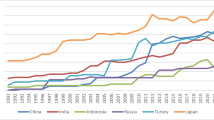Abstract
This study takes environmental policy stringency and economic activity as the controlling variables and forecasts the CO2 emissions in China up to 2022. In doing so, an application of corrected grey model with convolution is used over the annual time series data between 1990 and 2012. The simulation results show that (1) between 2012 and 2022, CO2 emissions in China is expected to increase at an average rate of 17.46% annually, raising the emissions intensity from 7.04 in 2012 to 25.461 metric tons per capita by 2022; (2) stringent environmental policies reduce CO2 emissions—whereas, GDP tends to increase the emissions intensity in China; (3) stringent environmental policies are found to have a negative impact on GDP in China. Based on the empirical findings, the study also provides some policy suggestions to reduce emissions intensity in China.




Similar content being viewed by others
Notes
The EPS is developed using a composite index approach; for details, see Botta and Kozluk (2014).
For details, see. https://stats.oecd.org/Index.aspx?DataSetCode=EPS.
References
Adamović V M, Antanasijević D Z, Ristić M D, Perić-Grujic A A, Pocajt V V (2017) Prediction of muncipal solid waste generation using artificial neural network approach enhanced by structural break analysis. Environ Sci Pollut Res 24(1):299–311
Ahmed K, Bhattacharya M, Qazi A, Long W (2016) Energy cinsumption in China and underlying factors in a changing landscape: empirical evidence since the reform period. Renew Sustain Energy Rev 58:224–234
Auffhammer M, Carson R T (2008) Forecasting the path of China’s CO 2 emissions using province-level information. J Environ Econ Manag 55(3):229–247
Botta E, Kozluk T (2014) Measuring environmental policy stringency in OECD countries: a composite index approach. OECD Econ Depart Work Papers 1177:0–1
Calel R, Dechezlepretre A (2016) Environmental policy and directed technological change: evidence from the European carbon market. Rev Econ Statist 98(1):173–191
Chen W, Lei Y (2017) Analysis of the impact path on factor of China’s energy-related CO2 emissions: a path analysis with latent variables. Environ Sci Pollut Res 24(6):5757–5772
Chow GC (2010) China’s environmental policy: a critical survey. Center for Economic Policy Studies, Princeton University
Deng JL (1982) Control problems of grey systems. Syst Control Lett 1(5):288–294
Deng JL (2002) The elements of grey theory. HUST Press, Wuhan
Frondel M, Horbach J, Rennings K (2008) What triggers environmental management and innovation? Empirical evidence for Germany. Ecol Econ 66(1):153–160
Gentle P (2016) China’s environmental policy and urban development
Jalil A, Mahmud SF (2009) Environmental Kuznets curve for CO2 emissions: a cointegration analysis for China. Energ Polic 37(12):5167–5172
Jayanthakumaran K, Verna R, Liu Y (2012) CO2 emissions, energy consumption, trade and income: a comparative analysis of China and India. Energ Polic 42:450–460
Johnstone N, Haščič I, Poirier J, Hemar M, Michel C (2012) Environmental policy stringency and technological innovation: evidence from survey data and patent counts. Appl Econ 44(17):2157–2170
Lanoie P, Laurent-Lucchetti J, Johnstone N, Ambec S (2011) Environmental policy, innovation and performance: new insights on the Porter hypothesis. J Econ Manag Strat 20(3):803–842
Liang QM, Fan Y, Wei YM (2007) Multi-regional input–output model for regional energy requirements and CO2 emissions in China. Energ Polic 35(3):1685–1700
Liu SF, Dang YG, Fang ZG (2004) Grey system theory and its applications. Sciences Press, Beijing
Moore FC, Diaz DB (2015) Temperature impacts on economic growth warrant stringent mitigation policy. Nat Clim Change 5(2):127–131
Ravallion M (2013) How long will it take to lift one billion people out of poverty? The World Bank Research Observer 28(2):139–158
Saboori B, Rasoulinezhad E, Sung J (2017) The nexus of oil consumption and South Korea. Environ Sci Pollut Res 24(8):7436–7455
Schreurs MA (2016) The Paris climate agreement and the three largest emitters: China, the United States, and the European Union. Polit Govern 4(3):219–223
Song YC, Zhang ZQ (2012) Prediction on energy requirements of China “12th Five Planning” based on ARIMA model. Coal Eng 44(1):76–79
Wang ZX (2015) A predictive analysis of clean energy consumption, economic growth and environmental regulation in China using an optimized grey dynamics model. Comput Econ 46(3):437–453
Wang HT, Mu SR (2010) The characteristics and trend of carbon emissions in Beijing. Urban Stud 17 (9):55–61
Xing XJ, Zhou DQ (2008) The predictive function of Chinese energy demand: co-integration analysis assisted by principal components. J Appl Stat Manag 27(6):945–951
Zhang YJ (2011) The impact of financial development on carbon emissions: an empirical analysis in China. Energ Polic 39(4):2197–2203
Zhu Q, Peng X (2012) The impacts of population change on carbon emissions in China during 1978-2008. Environ Imapct Assess Rev 36:1–8
Author information
Authors and Affiliations
Corresponding author
Additional information
Responsible Editor: Philippe Garrigues
Appendix
Appendix
A grey model GM(1,1) is applied in order to examine the independent dynamics of CO2 emissions. It can be seen from the Table 8 results given that CO2 emissions are expected to be increased until no other factors are taken to control/influence this increase (Fig. 5).
Rights and permissions
About this article
Cite this article
Ahmed, K., Ahmed, S. A predictive analysis of CO2 emissions, environmental policy stringency, and economic growth in China. Environ Sci Pollut Res 25, 16091–16100 (2018). https://doi.org/10.1007/s11356-018-1849-x
Received:
Accepted:
Published:
Issue Date:
DOI: https://doi.org/10.1007/s11356-018-1849-x





